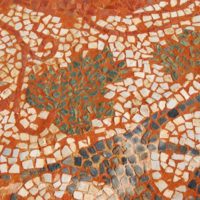Mosaic residence
POI Item Type Metadata
Latitude
40.880065
Longitude
25.512698
WebContent
Mosaic residence The excavations in the ancient town of Maronia started in the late 1960s and despite the extensive destruction from which the region suffered, the excavation data, combined with the findings, and specially the coins, offer important information for the life of the inhabitants. It was a populous city because according to estimations, the population exceeded the 12,000 inhabitants. On the places Alki and Mesonisi, the cemetery of the town was excavated, which is also dated in the 4th century BC.
Southwest of the Ancient Theatre, three buildings of the 4th century have been uncovered, with an impressive retaining wall which holds their terraces.
Southwest of the Ancient Theatre there is the district with the famous houses of the Maronites from the 4th and 3rd century BC century. The rooms have been built around two courtyards, one paved, leading to the service rooms of the house, the kitchen and bathroom and a patio with a colonnade, which leads to the main room of the house, the "androna". One courtyard, the one which is dated in the 3rd century BC, has an area of 645 sq.m and features mosaic floors.
The floor plan represents a typical example of the later classical house of ancient Maronia, which, like the theater, as regards their construction, they follow the principles of the Roman author and architect Vitruvius. The distribution of the spaces of the house around two courtyards, corresponds to the description of the "Greek house" in the 9th chapter of the sixth book of Vitruvius with the title "On Architecture" (1st century BC). So, according to the text of the treatise of this great architect, the open-air sites are the two-thirds of the semi-open spaces and about half of the enclosed spaces. Public from private spaces are also distinguished and even the spaces for rest and fun, as well as the family rooms of slaves and animals.
At the place of Paleopigada, late Classical - Hellenistic houses have been excavated. In a house which is dated from the late 4th to the early 3rd century BC, a colorful mosaic floor is preserved in the main room of the house (androna). It is made with natural stones that create geometric patterns and display fruit and vine leaves.
Detail of the mosaic floor with vine leaves and fruits.
Southwest of the Ancient Theatre, three buildings of the 4th century have been uncovered, with an impressive retaining wall which holds their terraces.
Southwest of the Ancient Theatre there is the district with the famous houses of the Maronites from the 4th and 3rd century BC century. The rooms have been built around two courtyards, one paved, leading to the service rooms of the house, the kitchen and bathroom and a patio with a colonnade, which leads to the main room of the house, the "androna". One courtyard, the one which is dated in the 3rd century BC, has an area of 645 sq.m and features mosaic floors.
The floor plan represents a typical example of the later classical house of ancient Maronia, which, like the theater, as regards their construction, they follow the principles of the Roman author and architect Vitruvius. The distribution of the spaces of the house around two courtyards, corresponds to the description of the "Greek house" in the 9th chapter of the sixth book of Vitruvius with the title "On Architecture" (1st century BC). So, according to the text of the treatise of this great architect, the open-air sites are the two-thirds of the semi-open spaces and about half of the enclosed spaces. Public from private spaces are also distinguished and even the spaces for rest and fun, as well as the family rooms of slaves and animals.
At the place of Paleopigada, late Classical - Hellenistic houses have been excavated. In a house which is dated from the late 4th to the early 3rd century BC, a colorful mosaic floor is preserved in the main room of the house (androna). It is made with natural stones that create geometric patterns and display fruit and vine leaves.
Detail of the mosaic floor with vine leaves and fruits.
Entrance
Characterization
TH
Files
Collection
Citation
“Mosaic residence,” iGuide Repo, accessed December 5, 2025, http://ubuntu01.ceti.gr/omeka/items/show/1626.
Item Relations
| This Item | dcterms:isPartOf | Item: Maronia |
| Item: Mosaic residence | dcterms:isPartOf | This Item |
| Item: Mosaic residence | dcterms:isPartOf | This Item |
| Item: Mosaic residence | dcterms:isPartOf | This Item |
| Item: Mosaic residence | dcterms:isPartOf | This Item |




